Похожие презентации:
Cellular biophysics
1. CELLULAR BIOPHYSICS Selected Topics Lecture 1
2.
What is Biophysics?It is neither “physics for biologists”, nor “physical methods
applied to biology”
It is a modern, interdisciplinary field of science leading to new
approaches for our understanding of biological functions.
Mathematics +Physics +Biology + Chemistry
Paradigm: “Biological system is not simply the sum of its
molecular components but is rather their functional integration”
–example biological membrane.
3. Intersection (not union) of Biology, Physics and:
Computer-Science& Math
Chemistry &
Technology
Genomics
& Systems
Biology, Ecology, Society, & Evolution
3
4.
The purpose of the course:A concise review of MAJOR CONCEPTS OF SELECTED TOPICS
in BIOPHYSICS, describing cellular function with the focus on
unifying principles and mechanisms, with links to the physicochemical properties of the components; a consideration of the
energetic and kinetic aspects of the processes; and the strategies
and KEY TECHNIQUES used in performing the studies.
Two exams: mid-term exam (20% of the total points)
And the final (30% of the grade)
Attendance -15%;
Work in the Class/mini-qizzes/ project-35%
5.
Biological MembraneHighly organized anisotropic structure
Relationship STRUCTURE-FUNCTION are central to biophysics
6. William Thomson (Lord Kelvin)
”I often say that when you can measure what you
are speaking about, and express it in numbers, you
know something about it; but when you cannot
measure it, when you cannot express it in numbers,
your knowledge is of a meagre and unsatisfactory
kind; it may be the beginning of knowledge, but you
have scarcely, in your thoughts, advanced to the
stage of science, whatever the matter may be”.
1883, “Electrical units of measurements”
7. Charles Darwin
“I have deeply regretted that I did notproceed far enough at least to understand
something of the great leading principles of
mathematics, for men thus endowed seem
to have an extra sense.”
• Autobiography, 1997
8. Why we should care about the numbers in biology?
• The importance of biological numeracycenters on the way in which a quantitative
formulation of a given biological
phenomenon allows us to build models in
order to understand HOW it works.
9.
Examples of problems to solve:How brain processes and stores information?
How the heart pumps blood?
How muscles contract?
How plants use light for grow in photosynthesis?
How genes are switched on and off?
10. What is the goal of biophysics?
• (1) create simplified models• (2) make quantitative predictions
• (3) Experimentally test quantitative
predictions
11. .
• Most of what we know in Physics hasbeen derived from experience with
the inanimate world. It is a
challenge to transfer these concepts
to living objects such as cells,
tissues, and entire organisms, where
it is not certain if they are
appropriate or even relevant.
12. Why Model?
• To understand biological/chemical data.(& design useful modifications)
• To share data we need to be able to
search, merge, & check data via models.
• Integrating diverse data types can reduce
random & systematic errors.
12
13.
14. What are biophysicts study? (Heidelberg)
• Collective cell migration (Spatz)- is the process of several cellsmigrating as a cohesive group, in which each individual actively
coordinates its own movement with that of its neighbors
• Engineering of synthetic cells (Platzman)-The major aim of our
interdisciplinary research is the bottom-up assembly of synthetic
cells which can adhere, migrate and divide.
• Biophysics of cell interactions (Boehm)-Many mammalian cells
are enveloped by a sugar-protein coat. This coat mainly consists of
hyaluronan (HA) and plays a major role in all interactions of the cell
with its environment. Thus our main research interest is the analysis
of cellular interactions in response to HA.
• Spectroscopy technologies (Zamir and Majer)-Reconceptualizing
fluorescence correlation spectroscopy for monitoring and analyzing
of periodically passing objects.
• Super-resolution microscopy technology- (S.Hell)-Current efforts
of this interdisciplinary group of physicists, chemists and biologists
aim to improve resolution, contrast, speed and versatility of optical
15.
The primary objective of the program is to educate and trainindividuals with this background to apply the concepts and
methods of the quantitative sciences to the solution of
biological problems.
16.
Divisions of Biophysics:Molecular biophysics
Biomechanics
Membrane Biophysics
Bio-electrochemistry
Environmental Biophysics
Impact on
biotechnology and
medicine
Theoretical Biophysics
Biophysical Techniques
(general, imaging, medical)
17. HOW: Biophysical techniques and applications
18. Engine of discovery:Biophysical techniques and applications
19. Biophysical techniques and applications
20.
History: First “Biophysicists”Heraclitus 5th century B.C. – earliest mechanistic theories of
life processes, insight into dynamic.
“Change is central to Universe”.
“Logos is the fundamental order of all “on Nature” changes of
objects with the flow of time”
“You can not step twice into the same river”
21.
First “Biophysicists”Epicurus 3rd century B.C. – atom. Living organisms follow
the same laws as non-living objects.
Galen 2th century AD – physician, most accomplished
medical researcher of the Roman period. His theories
dominated Western medicine for over millennium.
Better anatomy only by Vesalius in 1543
Better understanding of blood and heart in 1628
Leonardo da Vinci 16th century – mechanical principles of
bird flight (to use for engineering design) - BIONICS
22.
Borelli farther of biomechanicsGiovanni Alfonso Borelli 17th century- related
animals to machines and utilized mathematics to
prove his theories.
De Motu Animalium – comprehensive
biomechanical description of limb’s mobility, bird’s
flight, swimming movement, heart function.
23.
Luigi Galvani / Alessandro VoltaBio-electrochemistry
18th (1771) Galvani touched frog nerve with charged scalpel.
Signal transduction in neurons and communication between neurons and muscle has
electrical nature.
24.
Luigi Galvani / Alessandro VoltaFrom frog leg to first battery.
With two different metals
effect is stronger.
Contact potential !!
Electric circuit = two different metals + sciatic nerve of the frog
Nerve of the frog's leg = electrolyte and sensor
Metals = electrodes
If close the circuit dead leg will twitch.
Volta created first battery by substituting frog leg with electrolyte.
25. OFFICIAL BIRTH OF BIOPHYSICS
26.
History of discoveries in Biophysics:Optical aspects of the human eye
Theory of hearing
Brown’s motion
Osmotic process
Nonequilibrium thermodynamics
Discovery of X-rays – emergence of radiation biophysics
Discovery of DNA structure
Information theory
Statistical physics of biopolymers
…
27.
Transmission of order from one organism to it’s descendantsThe major advance in understanding the nature of gene mutation and gene
structure. The work was a keystone in the formation of molecular genetics.
28. Quantitative definition of life?
Probability of replication … simple in, complex out(in a specific environment)
Robustness/Evolvability
(in a variety of environments)
Challenging cases:
Physics: nucleate-crystals, mold-replica, geological layers, fires
Biology: pollinated flowers, viruses, predators, sterile mules,
Engineering: self-assembling machines.
Structure, function, replication, growth, origin, evolution…
.
29. Schroedinger cat
30.
31. In order to function:
All groups of living organisms on Earth share several keycharacteristics:
• Order; Sensitivity or response to stimuli; Reproduction;
Growth and Development; Homeostasis; Energy
processing
• All living things detect changes in their environment
and respond to them. All living things are capable of
reproduction, the process by which living things give
rise to offspring. All living things are able to maintain
a constant internal environment through
homeostasis. All forms of life are built of CELLS.
.
32. Are viruses alive??
(computer & biological viral codes)AIDS - HIV-1
36.9 mln dead (worse than black
plague & 1918 Flu)
Computer viruses & hacks :
over $3 trillion/year (Most costly
virus MyDoom-$38 billions in damages
Polymerase drug resistance mutations
M41L, D67N, T69D, L210W, T215Y,
H208Y
PISPIETVPVKLKPGMDGPK
VKQWPLTEEK
IKALIEICAE LEKDGKISKI
GPVNPYDTPV FAIKKKNSDK
WRKLVDFREL NKRTQDFCEV
33. Conceptual connections
ConceptComputers
Organisms
Instructions
Bits
Stable memory
Active memory
Environment
I/O
Monomer
Polymer
Replication
Sensor/In
Actuator/Out
Communicate
Program
0,1
Disk,tape
RAM
Sockets,people
AD/DA
Minerals
chip
Factories
Keys,scanner
Printer,motor
Internet,IR
Genome
a,c,g,t
DNA
RNA
Water,salts
proteins
Nucleotide
DNA,RNA,protein
1e-15 liter cell sap
Chem/photo receptor
Actomyosin
Pheromones, song
34. Self-compiling & self-assembling
Self-compiling & self-assemblingComplementary surfaces
Watson-Crick base pair
(Nature April 25, 1953)
MC. Escher
35. Minimal Life: Self-assembly, Catalysis, Replication, Mutation, Selection
Cell boundaryMonomers
RNA
.
36. Replicator diversity
Self-assembly, Catalysis, Replication, Mutation, SelectionPolymerization & folding (Revised Central Dogma)
Monomers
DNA
RNA
Protein
Growth rate
Polymers: Initiate, Elongate, Terminate, Fold, Modify, Localize, Degrade
/
37. Maximal Life:
Self-assembly, Catalysis, Replication, Mutation, SelectionRegulatory & Metabolic Networks
Interactions
Metabolites
DNA
RNA
Protein
Growth rate
Expression
.
Polymers: Initiate, Elongate, Terminate, Fold, Modify, Localize, Degrade
38. Types of Systems Interaction Models
Quantum ElectrodynamicsQuantum mechanics
Molecular mechanics
Master equations
Fokker-Planck approx.
Macroscopic rates ODE
Flux Balance Optima
Thermodynamic models
Steady State
Metabolic Control Analysis
Spatially inhomogenous
Population dynamics
subatomic
electron clouds
spherical atoms
nm-fs
stochastic single molecules
stochastic
Concentration & time (C,t)
dCik/dt optimal steady state
dCik/dt = 0 k reversible reactions
SdCik/dt = 0 (sum k reactions)
d(dCik/dt)/dCj (i = chem.species)
dCi/dx
as above
km-yr
Increasing scope, decreasing resolution
39. Integrate : Optimal BioSystems
•Elements of Life-Molecules & PurificationSystems Biology & Applications of Models
Life Components & Interconnections
Continuity of Life & Central Dogma
Qualitative Models & Evidence
Synthetic Life
.
40. From atoms to (bio)molecules
H2OCH4
NH3
H2S
PH3
H2 , O2
C60
N2
Sn
H+ , OHCO3NO3SO4-- Mg++
K+PO4-- Na+
Gas
Elemental
Salt
41. STEP 1: Purify
Elements,molecules,
assemblies,
organelles,
cells,
organisms
Clonal growth
chromatography
41
42. Purified history
Pre 1970s: Column/gel purification revolutionMid-1970s: Recombinant DNA brings
clonal (single-step) purity.
1984-Now: Sequencing genomes & automation
aids return to whole systems.
Whole genome sequencing.
.
43. Integrate : Optimal BioSystems
Elements of Life-Molecules & Purification---Systems Biology & Applications of Models
Life Components & Interconnections
Continuity of Life & Central Dogma
Qualitative Models & Evidence
Synthetic Life
.
44. Why Genomes & Systems?
Why Genomes & Systems?#0. Why sequence the genome(s)? To allow #1,2,3
below.
#1. Why map variation?
#2. Why obtain a complete set of human RNAs, proteins
& regulatory elements?
#3. Why understand comparative genomics and how
genomes evolved? To allow #4 below.
#4. Why quantitative biosystem models of molecular
interactions with multiple levels (atoms to cells to
organisms & populations)?
To share information. CONSTRUCTION is a test of
understanding & to make useful products.
.
45. Number of component types (estimate)
M.genBases .58M
DNAs 1
Genes .48k
RNAs .4k
Proteins
.6k
Cells
1
Worm Human
>97M 3000M
7
25
19k
21k
>30k
.2-3M
>50k
.3-10M
959
1014
.
46. The simplest amino acid component of proteins
GlycineGly
G
config(glycine,[
substituent(aminoacid_L_backbone),
substituent(hyd),
linkage(from(aminoacid_L_backbone,car(1)),
to(hyd,hyd(1)),
nil,single)]).
.
47. 20 Amino acids of 280
T.
48. Some Grand (& useful) Challenges
Some Grand (& useful) ChallengesA) From atoms to evolving minigenome-cells.
• Improve in vitro macromolecular synthesis.
• Conceptually link atomic (mutational) changes to population evolution
(via molecular & systems modeling).
• Novel polymers for smart-materials, mirror-enzymes & drug selection.
B) From cells to tissues.
• Model combinations of external signals & genome-programming on expression.
• Manipulate stem-cell fate & stability.
• Engineer reduction of mutation & cancerous proliferation.
• Programmed cells to replace or augment (low toxicity) drugs.
C) From tissues to physiological & eco- systems
• Programming of cell and tissue morphology.
• Quantitate robustness & evolvability.
• Engineer sensor-effector feedback networks where macro-morphologies
determine the functions; past (Darwinian) or future (prosthetic).
.
49. Continuity of Life & Central Dogma
Continuity of Life & Central DogmaSelf-assembly, Catalysis, Replication, Mutation, Selection
Regulatory & Metabolic Networks
Interactions
Metabolites
DNA
RNA
Protein
Growth rate
Expression
Polymers: Initiate, Elongate, Terminate, Fold, Modify, Localize, Degrade
.
50. "The" Genetic Code
"The" Genetic CodeM
F
x=
3’ uac
5'... aug
3’aag
uuu ...
Adjacent mRNA codons
Uxu
uxc
uxa
uxg
Cxu
cxc
cxa
cxg
u
c
F
L
‘Silent’ codon changes
Y
C
H
W
P
TER
R
Q
N
I
S
T
C-S
K
R
M
NH+
gxu
gxc
gxa
gxg
g
S
axu
axc
axa
axg
a
D
V
A
G
O-
E
H:D/A
.
51. Translation t-,m-,r-RNA
Ban N, et al. 1999 Nature. 400:841-7.Large macromolecular complexes:
Ribosome: 3 RNAs (over 3 kbp plus
over 50 different proteins)
Science (2000) 289: 878, 905, 920, 3D coordinates.
.
52. How many living species?
5000 bacterial species per gram of soil (<70% DNA bp identity)Currently: 8,7 million species on Earth (eukaryotic); bacterial and
archea (from 100,000 to 10 millions)
During last 250 years, 1.2 million eukaryotic species have been
identified and taxonomically classified
1st sequenced – Haemophylus influenzae, 1995
Whole genomes: 17,420 bacteria; 362 Archea; 98 insects; 150 plants;
235 terrestrial vertebrates (80 mammalians)
(Data from 2014, “Scientist”)
& Why study more than one species?
Comparisons allow discrimination of
subtle functional constraints.
.
53. Continuity & Diversity of life
Continuity & Diversity of life.
54.
Question biophysicists ask: How life generates order?2nd law of thermodynamic - in isolated system molecular
disorder never decreases spontaneously.
Question: why Earth is full of life which is highly organized?
Vitalism?
55.
The Concept of Free Energy:-“useful” energy of a system
- the part of total energy that can be harnessed to do “useful” work
F=E-TS
(total energy – randomness (or disorder))
If F<0 – process is spontaneous, T=constant
F can decrease if
E decreases (exmp. - heat loss)
S increases (disorder tents to increase)
Life doesn’t create order from nowhere. Life captures order,
ultimately from the Sun. Prosesses of free energy transduction then
transmit order through the biosphere.




























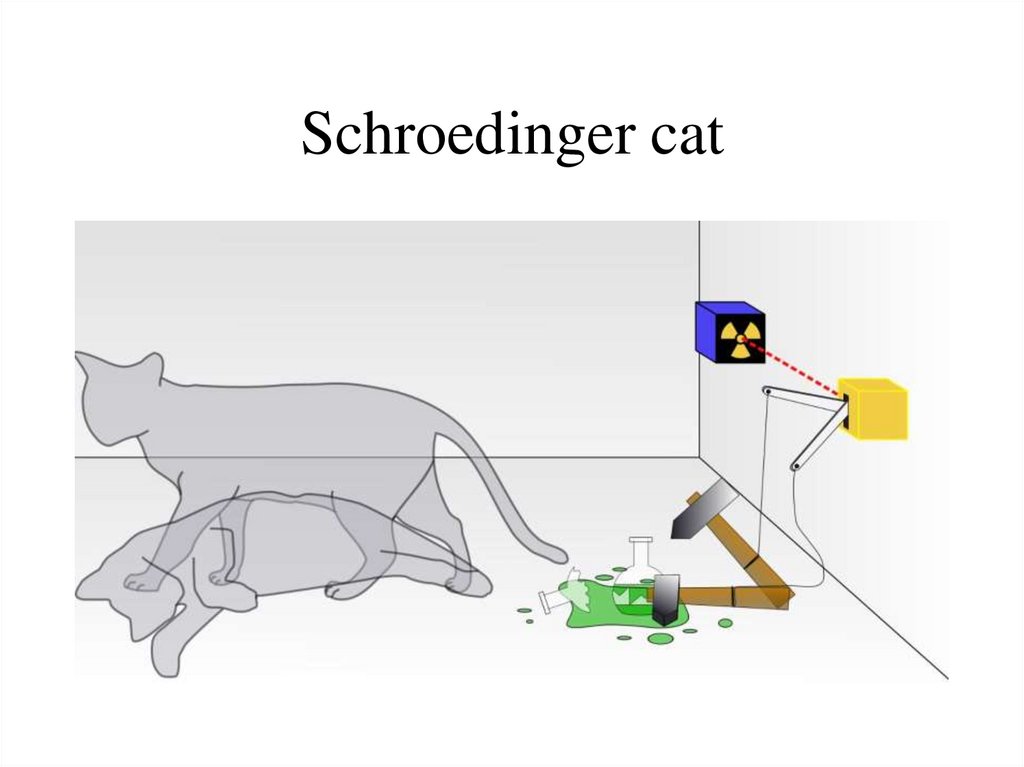

















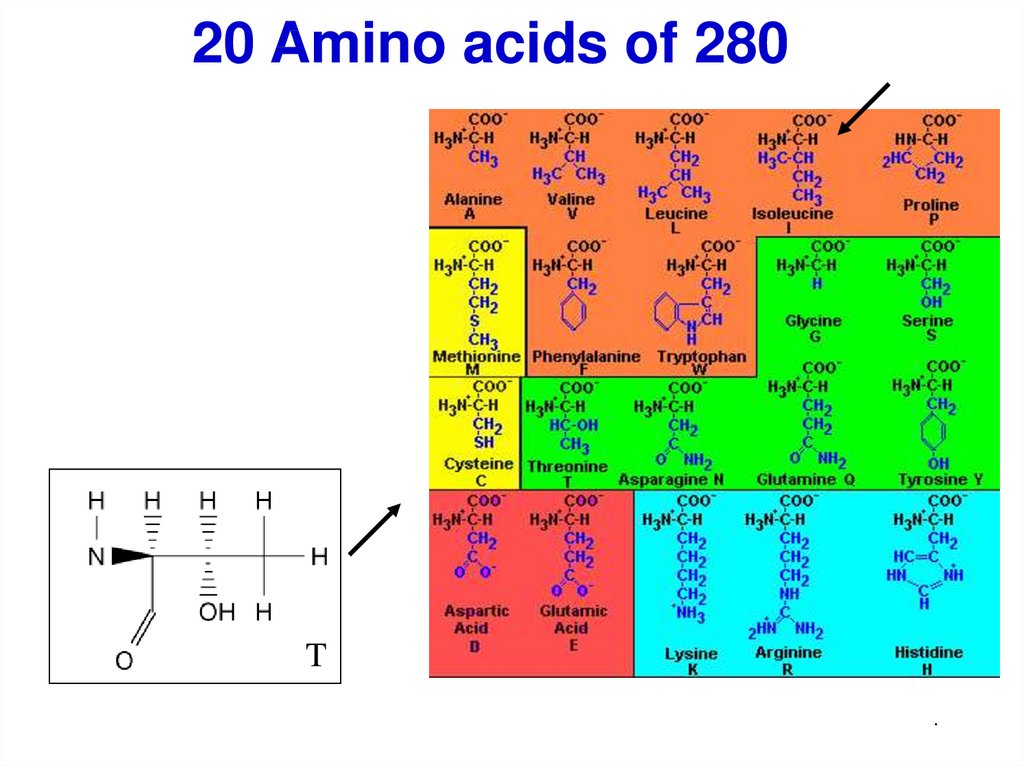

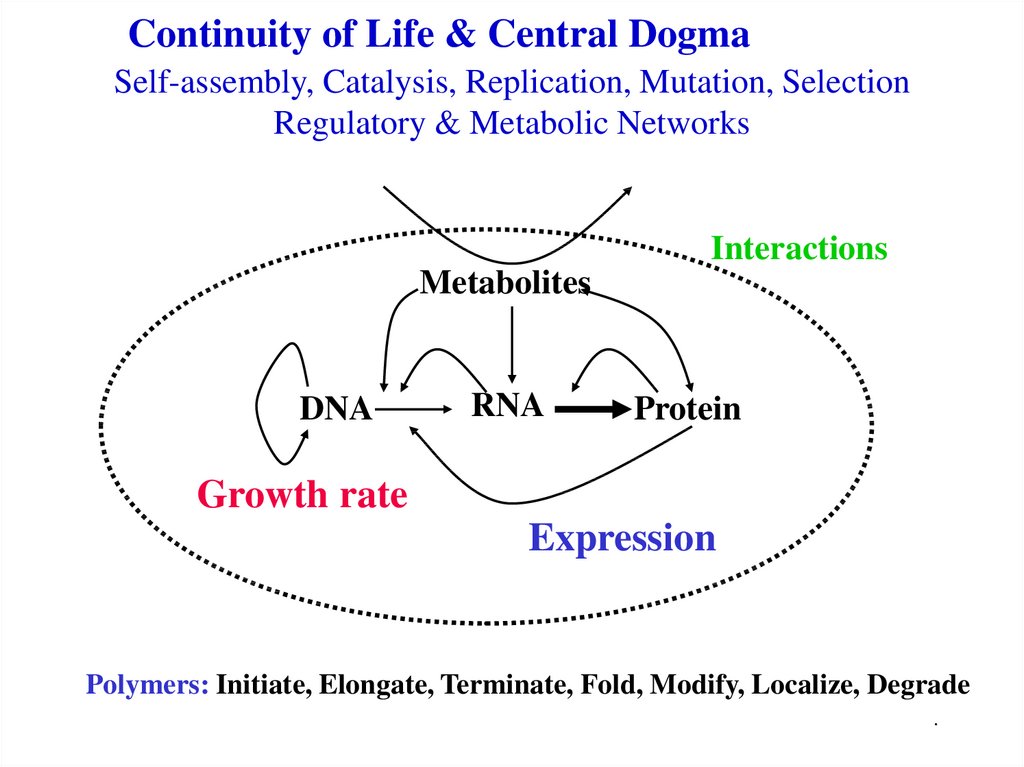
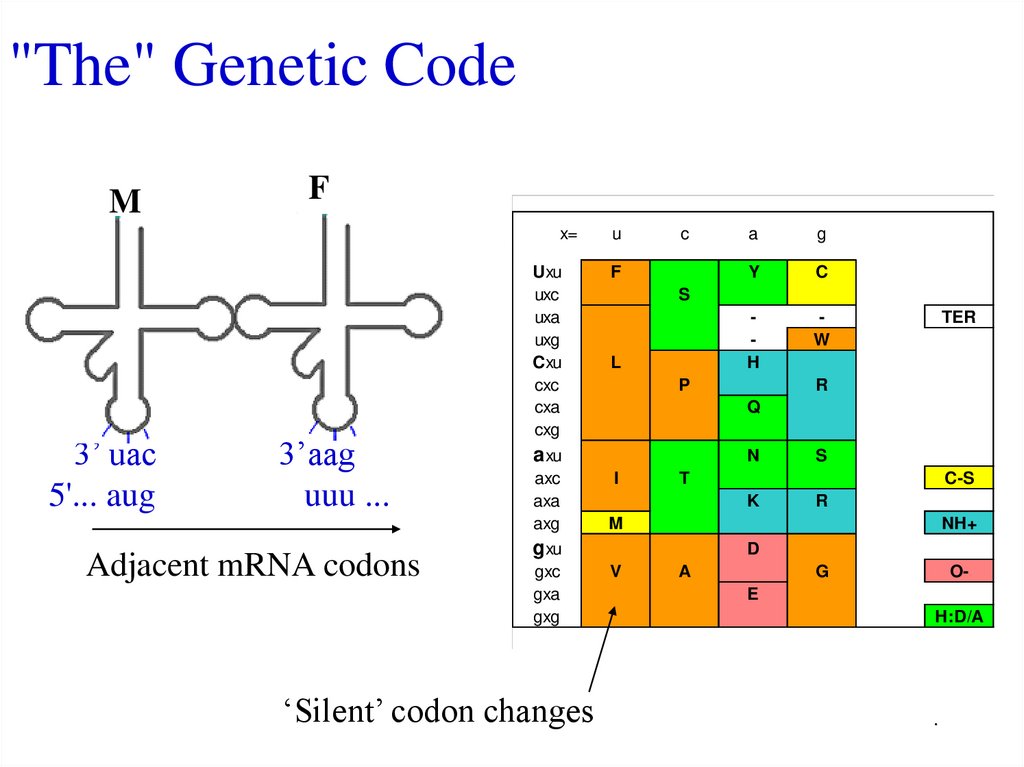


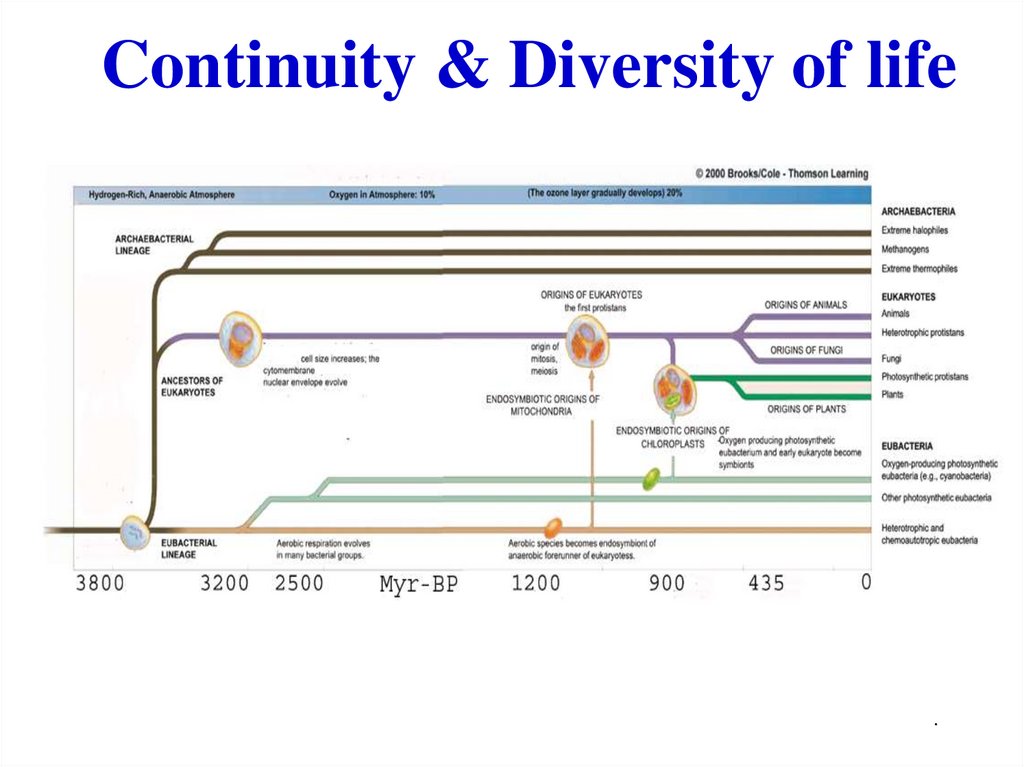

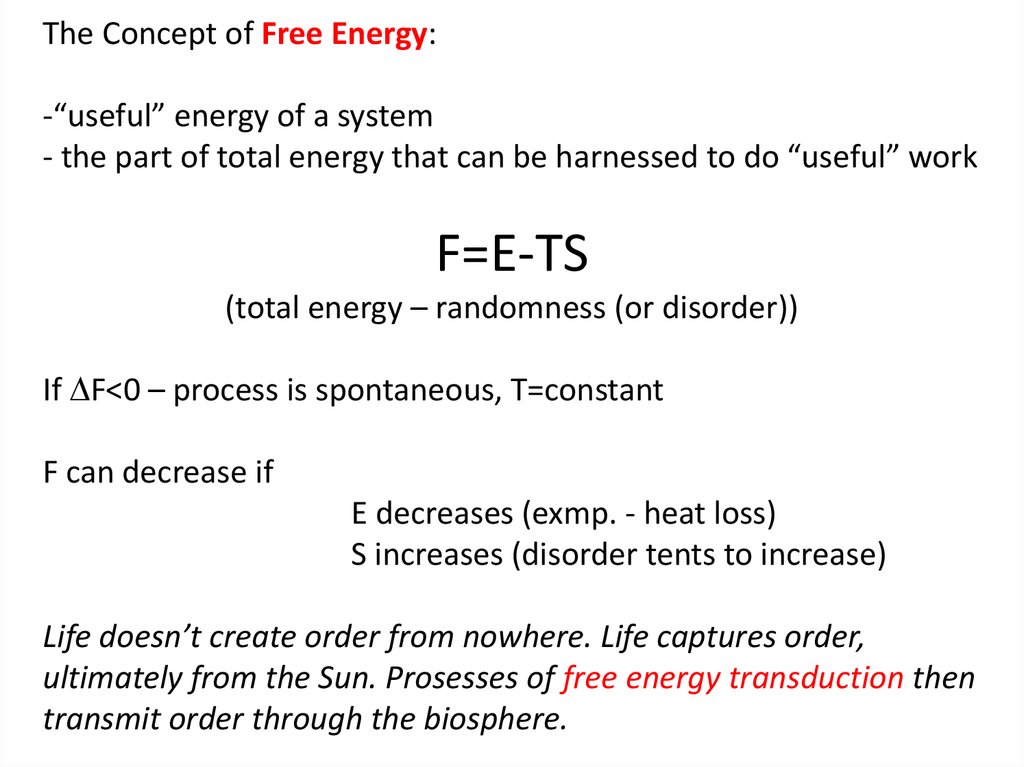
 Биология
Биология








